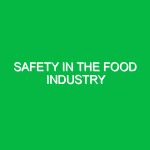In a world that increasingly prioritizes health and safety, understanding food handling safety for non-food workers has become essential. But what does this entail? Food handling safety refers to the protocols and practices designed to prevent foodborne illnesses and ensure the safe consumption of food. While it might seem that this topic only concerns chefs and food service employees, non-food workers across various industries also play a crucial role in maintaining food safety standards. This article aims to delve into the relevance of food handling safety in the Health, Safety, and Environment (HSE) domain, exploring potential hazards, best practices, and regulatory standards that govern this critical aspect of workplace safety.
The Importance of Food Handling Safety for Non-Food Workers
Many non-food workers, including maintenance staff, administrative personnel, and delivery drivers, can inadvertently affect food safety. For instance, a delivery driver may not realize that how they store food during transport can lead to contamination. Similarly, maintenance workers who service kitchen equipment must be aware of hygiene practices to avoid cross-contamination. Therefore, understanding food handling safety is not just for those who prepare food; it’s vital for anyone who interacts with food products in any capacity.
Identifying Hazards and Risks
When considering food handling safety for non-food workers, it’s crucial to identify the various hazards and risks that may arise. These can be categorized into several types:
Biological Hazards
Biological hazards include bacteria, viruses, and parasites that can contaminate food. For example, norovirus outbreaks often trace back to contaminated surfaces or workers who fail to wash their hands properly. Non-food workers may inadvertently spread these pathogens if they do not follow hygiene protocols. A personal anecdote comes to mind: a friend who worked in an office cafeteria once saw a janitor cleaning the dining area without wearing gloves. This oversight could lead to serious health risks for anyone consuming food in that environment.
Chemical Hazards
Chemical hazards refer to harmful substances that can contaminate food, such as cleaning agents and pesticides. For instance, if a maintenance worker uses a chemical cleaner near food storage areas without proper precautions, it could lead to accidental contamination. Understanding Material Safety Data Sheets (MSDS) is crucial for any worker handling chemicals, as these documents provide essential information on the safe use and potential hazards of various substances.
Physical Hazards
Physical hazards involve foreign objects that can contaminate food, such as hair, glass, or metal fragments. Maintenance workers, for example, should ensure that no tools or materials remain in food preparation areas after servicing equipment. A case study from a restaurant highlighted how a piece of broken glass from a light fixture ended up in a salad, leading to severe injuries and a lawsuit. This incident underscores the importance of vigilance in environments where food is present.
Best Practices and Safety Precautions
To mitigate these hazards, non-food workers must adopt specific safety precautions. Here are some best practices to follow:
Hand Hygiene
Washing hands is one of the most effective ways to prevent the spread of foodborne illnesses. Non-food workers should wash their hands with soap and water for at least 20 seconds before and after handling food, using the restroom, or touching any surfaces that may harbor contaminants. It’s a simple practice but can save lives.
Use of Personal Protective Equipment (PPE)
Using appropriate PPE, such as gloves and masks, can significantly reduce the risk of contamination. For instance, when performing maintenance tasks in a kitchen, wearing gloves while handling food-related equipment can prevent the transfer of bacteria. Training sessions on the correct use of PPE should be mandatory for all workers interacting with food.
Proper Cleaning and Sanitizing
Regular cleaning and sanitizing of surfaces and equipment are crucial. Non-food workers should be trained to use approved cleaning agents and understand the difference between cleaning (removing dirt) and sanitizing (killing germs). A well-implemented cleaning schedule can greatly reduce the risk of contamination.
Safe Food Storage Practices
Understanding food storage guidelines is essential. For example, maintaining proper temperature controls (keeping refrigerated items below 40°F) is critical to prevent bacterial growth. Non-food workers involved in food storage or transport should be aware of these guidelines to ensure food safety.
Awareness and Training
Continuous training on food handling safety is essential for non-food workers. This could include workshops or e-learning modules covering the basics of food safety, recognizing hazards, and understanding the importance of their role in maintaining a safe environment. A memorable instance from my own experience involved a training session that opened my eyes to how easily cross-contamination can occur in everyday tasks.
Regulations and Standards Governing Food Handling Safety
Several regulations and standards govern food handling safety, and it is vital for non-food workers to be aware of these to ensure compliance:
The Food Safety Modernization Act (FSMA)
In the United States, the FSMA aims to ensure the safety of the nation’s food supply by shifting the focus from responding to contamination to preventing it. This act emphasizes the importance of training for all workers, including non-food personnel, to understand their role in food safety.
HACCP Principles
The Hazard Analysis Critical Control Point (HACCP) is a systematic approach to food safety that identifies, evaluates, and controls hazards. Non-food workers should be familiar with HACCP principles, as their adherence can significantly reduce risks associated with food handling.
Local Health Regulations
Health regulations can vary by location, so non-food workers must be aware of their local guidelines. These regulations often include specifications for food storage, handling practices, and cleanliness standards. Compliance with these regulations is not merely a legal obligation; it is essential for safeguarding public health.
Conclusion
Food handling safety for non-food workers is an area that warrants attention and diligence from all employees, regardless of their primary role. The potential hazards are numerous, but with proper training, awareness, and adherence to best practices, these risks can be effectively managed. By understanding the significance of their contributions to food safety, non-food workers can help create a safer environment for everyone. Remember, food safety is a shared responsibility, and every worker plays a vital role in ensuring that food remains safe and healthy for consumption. In our interconnected world, it’s crucial that we all take this responsibility seriously.


